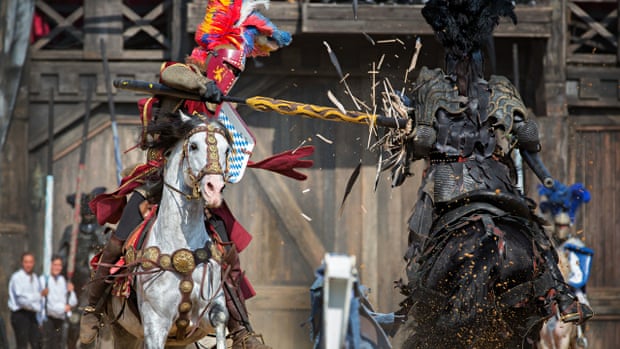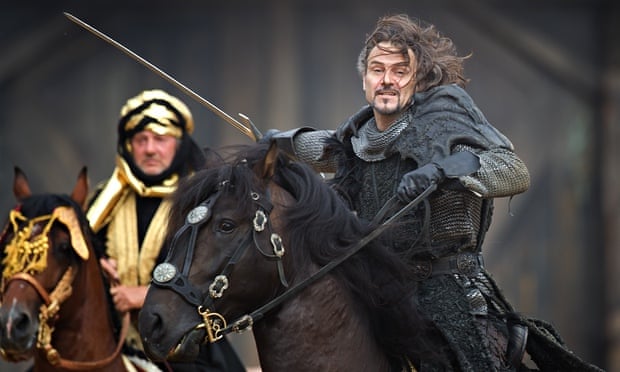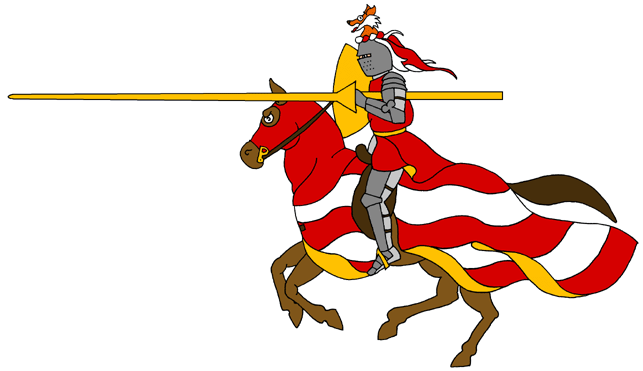Modern Knights Today

|
|||
|
|||
|
|||
|
* * *
* * *
* * *
|
|
|||
|
Every July, a little corner of Bavaria in southern Germany turns its back on the hi-tech world and embraces the blood and thunder of medieval society at the world’s biggest jousting tournament in Kaltenberg. It’s ‘like stepping through the screen into Game of Thrones’, says Christine Madden  Push through the mob at the gates of Kaltenberg castle some 50km west of Munich, in Bavaria, and you immediately lose all notion of being in Germany’s answer to silicon valley. People in capes and hoods, nobles in finely embroidered velvets, minstrels with lutes and knights in chain mail mill about the winding path up to the 13th-century fortress. We have just entered the world of the Kaltenberg knights’ tournament. For the past 35 years, Prince Luitpold of Bavaria - the great-grandson of Ludwig III, the last king of Bavaria - has been opening his castle gates to more than 1,000 medieval show people: journeymen, jugglers, singers, dancers, storytellers and knights in armour. The three hectares of land surrounding the castle become a bustling, noisy bazaar, which attracts an audience of more than 120,000 people each year.  It’s like stepping through the screen into Game of Thrones, but without the imminent threat of lost limbs. Performers mingle with the thousands of visitors – many of whom are also dressed in medieval attire – playing music, dancing and telling stories. We sing along with a group of troubadours on one of the five performance stages and watch a juggler roll a glass orb along his limbs as easily as a soap bubble. We enjoy meat cooked over open fires and bread pulled steaming out of enormous clay ovens, which we wash down with mead and ale served in stoneware mugs. (After which, we’re happy enough that the plumbing is very 21st century.)  When the town crier announces the imminent start of the joust, all activity converges on the knights’ tournament, which is the largest in the world. The wooden arena seats up to 10,000 spectators, and the night we’re there the stands are full. Together with Cavalcade, his team of equestrian acrobats, famous horse trainer and stunt choreographer Mario Luraschi stages a two-hour display of cavalier daring. Horses gallop with their riders through the audience into the arena. Lances crack and splinter as knights tilt at each other, balance and somersault on their steeds before tumbling to the ground. The spectacle is a bit like a panto that’s come to life into a vibrant pageant. As the sun sets, artful lighting and open torch flames transform the drama into an atmosphere of awe and mystery. |
|
|||
The KnightsWe are proud to present ten of the worlds greatest knights.  
Alix van ZijlAlix van Zijl was born in the Netherlands in 1978. A veterinairian by trade she owns her own practice employing 4 more vets. Alix has been riding horses since a child and competed in dressage before becoming interested in historical riding when she was introduced to it by Joram van Essen and Arne Koets, and began training with them in 2003. In 2009 she took the big step of ordering a custom made museum quality Milanese Armour. Then in 2010 she competed in her first joust in public with the most experienced historical jousting group in the Netherlands, Foundation HEI, of which she is now a board member. She is at the moment the only woman in Europe having done a joust with solid lances with steel coronels at the White Bear tournament in Nyborg, Denmark in 2013. She was also the first female to joust at the Royal Armouries in Leeds, United Kingdom, also in 2013. She rode at the Grand Tournament of Sankt Wendle, Germany in 2012, fighting in the melee. Alix rides her own andalusian stallion called Torero, that she got from spain when he was four years old. She trained him herself according the baroque principles taught at the Hofreitschule Buckeburg, Germany. |
|
|||
|
|||
|
|||
Arne KoetsA Dutchman of Norwegian descent, now living in Germany, has been interested in military history as long as he can remember. In 1997, at the tender age of 16, he started sword fighting and in 2000 was one of the founding members of the Stichting Historisch Educatief Initiatief, a foundation promoting education through living history and the leading Historical jousting group of the Netherlands. In 2001 started riding and rode his first joust in spring 2002. This launched his jousting career and he was a member of the winning ‘Burgundian’ team in 2003 and 2005 at the prestigious Sword of honour tournament at the Royal Armouries in Leeds. In 2004 he turned full time jouster and in 2006 moved to the Royal armouries in Leeds to work as a full time jouster and cavalry display rider. In 2007 he won the ‘Queens golden jubilee trophy’ as well as the ‘Arundel sword of chivalry’ and is still holder of the ‘American sword of chivalry’ since 2008. In 2009 he moved back to Holland to work at the Royal Dutch army museum as a project manager and continued his work as a jouster, swordfighter and fight choreographer. In 2010 he won the Ironfest joust, the first international jousts with solid lances and steel coronels since the period. In 2011 he moved to Germany to work at the Fürstliche Hofreitschule in Bückeburg as the Kurator for the pre-barock period, and joining their riding team. In 2012 he organized and rode at the Grand tournament of Sankt Wendel, winnig the Chivalry prize and coming second in the overall running. In 2013 he won the Historical joust in Moscow and the Blacktown historical joust. He has ridden in over 750 shows in fifteen countries on three continents in his career, and broken well over 1500 lances. Arne Koets is a by now a world renowned jouster and historical rider. Having worked at the Fürstliche Hofreitschule in Bückeburg he is specializing in the historical dressage needed for mounted combat. He regularly teaches both European martial arts on foot and historical dressage and has taught in as far afield as California and Australia. He is particularly interested in creating a healthy, reliable steed that goes on light aides. Through side movements he works towards collection. Through understanding make it easier for students to make structural progress themselves and get somewhere. Theory is combined with pragmatic practical tuition. Here is what one of the best known Authors on knights, armour and arms has to say about Arne: ‘There are now a great many people studying and practicing the martial arts of the medieval knight, but almost no one pursues these things as seriously, as intensely, and as successfully as Arne. There are very few modern people alive today who have attained a level of skill comparable to real knights of the Middle Ages. Arne could fight in a real tournament and he could win. He is a wonderful example of what can be achieved when you devote your life to something. Facing Arne in combat is pretty scary, but extremely good for your knightly education.’ Signed Dr. Tobias Capwell, Curator of Arms and Armour, The Wallace Collection, London, Author of many great and wonderful books, etc etc |
|
|||
 
Bertus BrokampBertus got involved in late medieval martial art activities in 2001. He attended and, in time, taught classes in Historical European Martial Arts and founded a related late medieval living history group. While pursueing his dream of bringing more cavalry to the reenactment scene he got into contact with Foundation HEI and started to learn how to ride horse in 2004. In the meantime he joined the team of the foundation as a valet on foot. Three years later, in 2007, he did his first joust, became a general member on the board and received his Master of Science degree by writing a thesis on landweren, the late medieval defense lines in the Netherlands and Holy Roman Empire. A year later he had finished making his own cuirass, based on a archaeological find from the Netherlands. In 2010 Bertus became chairman of Foundation HEI and became one of the regular and professional knights doing the jousts for the foundation and also in the historical open air museum Archeon in the Netherlands. Since 2011 Bertus is the proud owner of Andalusian stallion Talento. This young but superb Iberian horse was extensively trained for and ridden during the Great Tournament of Sankt Wendel in 2012. Talento has carried his knight through many a tournament since and is being been trained in the art of classical dressage. Most recent, in 2013, Bertus broke his first solid lance and competed in the great White Bear Tournament in Nyborg, Denmark. |
|
|||
 
Ivar Mauritz-HansenIvar is all about the adrenalin of combat, the skill of riding and fighting and the favor of the ladies. He began training olympic fencing at the age of 9 and later changed caliber from the épée to the longsword, pollaxe and lance. Ivar has competed in many shows and competitions in Norway and abroad in northern Europe both on foot and on his horse. His riding career dates back to 2006 breaking his first lance in 2008. |
|
|||
 
Joram van EssenJoram van Essen was born in New Zealand in 1975. An experienced rider he is also a professional teacher, historical saddle maker, amateur historian and researcher and has had a lifetime interest in historical european martial and equestrian pursuits. Joram moved to the Netherlands in 1999, to further purse this passion. Here he was a founding member of the Foundation Historical Education Initiative (Stichting HEI) that was started in 2000 to promote historical education and authentic historical recreation in the Netherlands. An avid jouster he has competed at many jousts around the world, including the prestigous international jousts at the Royal Armouries in Leeds, England, where he won the world individual championship in 2003 and the world team championships in 2003 and 2005. Recently he was declared the winer of the Grand Tournament of Sankt Wendal, Germany, in 2012, one of the most authentic jousts in modern times using solid wooden lances and sharp steel coronels. Continuing this interest in recreating the joust as accurately as possible he jousted with solid lances and steel coronels in Moscow, Russia, and Nyborg, Denmark, in 2013. Joram’s philosophy is that jousting is an Art, which requires training, dedication and team work between horse and rider. |
|
|||
|
|||
|
|||
 
Per Estein Prøis-RøhjellPer Estein Prøis-Røhjell, aka Pelle, was born in 1976, and he is married with two children. He works as a riding instructor in his own company Trollspeilet, that offers riding instruction all over Norway and abroad. He has participated in medieval tournaments in Denmark, Sweden, Germany and France, and was Tournament Champion at the Tournament of St Olav in Trondheim in 2012. Pelle retired his best tournament horse "Hugo" in 2013, and many people are curiously waiting to see how he will do with a new and inexperienced horse in 2014. |
|
|||
 
Petter EllingsenPetter is one of the most well-known and -traveled knights in Norway. He started to ride in 1998 with the sole purpose to learn to joust and recreate the way the medieval knights rode. Petter has competed internationally for the last 11 years and have jousted in 13 countries worldwide. He has done more than 400 shows, tournaments and events. Petter took part at The grand Tournament of ST. Wendel in 2012 and in 2013 he jousted in front of over 200 000 people in a Moscow park during the Times And Epochs festival. Petter runs his own company, Ridderhest, which trains and supplies horses for TV, Television and events. Amongst the work he’s done is several television series for the National Broadcasting channel in Norway(NRK), music videos and this year also a reality series called "The Last Viking". Petter also teaches stagefighting once a week at a local theatre highschool. In addition he is a certified horse transporter and transports horses all over Europe. |
|
|||
 
Wouter NicolaiAs a member of Stichting HEI, the premier Dutch display team for medieval mounted soldiery, Wouter is one of the Netherlands’ top historical jousters and a highly active international competitor. In 2013 he performed at the White Bear tournament in Nyborg (Denmark), Arundel international tournament (England) And the Tournament of the Phoenix (US). His occupation as a professional jouster at the well-known Archeon Museum Park enables him to constantly hone his skills with horse, lance and sword. Wouter is also active in researching and reconstructing historical horse equipment, such as medieval and roman saddles. |
|
|||
The Knights Of Royal EnglandThe Spectacular Knights of Royal England have the experience to offer you all manner of mediaeval entertainment for your special event. As the premiere jousting company in Europe staging over 60 shows each year and having performed at both large and small venues all over the world the Knights of Royal England from the National Jousting Association are able to offer a comprehensive portfolio of mediaeval entertainment and entertainers. Tournament ScoresFor the National Jousting Association 2015 Series Tour of CastlesWho's winning ? Keep up to date with the Jousting scores for the seasonKeep up to date with the latest scores from the Tournament Field. The coveted Champions Crown for 2015 will be decided over a series of over 60 Tournaments. Points will be awarded for all forms of the competition including tilting, skills on horseback and foot combat. It's important for the Knights to be ready and fit for when the season starts at Easter, an injury could seriously damage a knight's chances of winning and the winner will be truly able to call himself a true Champion Jouster. |
|
|||
Knights' tournamentsThe time of medieval knights's tournaments comes back to life, noble counts, knights from Tyrol and Bavarian nobleman fight for glory and honour in the “tournament of kings”. Witness the intense lance battles on horseback with the knights trying to strike the other down or fear for their life when they fight to death on foot! |






































